AUDI S4 2013 Owners Manual
Manufacturer: AUDI, Model Year: 2013, Model line: S4, Model: AUDI S4 2013Pages: 302, PDF Size: 75.61 MB
Page 201 of 302
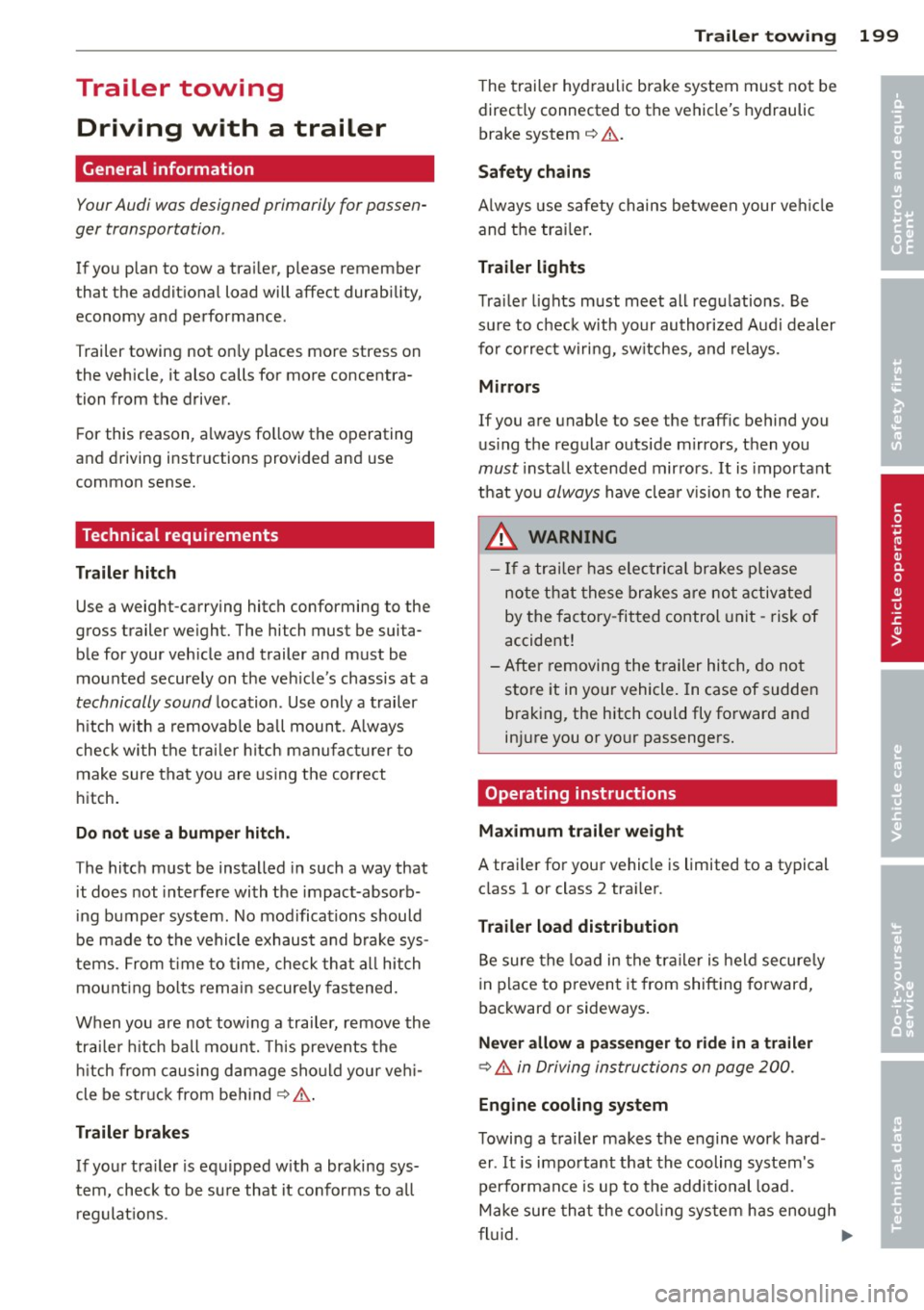
Trailer towing Driving with a trailer
General information
Your Audi was designed primarily for passen
ger transportation .
If you plan to tow a tra iler, p lease remember
that the addit ional load will affect durab ility,
economy and performance .
T railer towing not on ly places more stress on
the vehicle, it also calls for more concentra
tion from the driver.
F or this reason, a lways fo llow the operating
and driving instructions provided and use
common sense.
Technical requirements
Traile r hitch
Use a weight-carrying hitch conforming to the
gross trailer we ight. The hitch must be suita
b le for your veh icle and trailer and must be
mounted secure ly on t he veh icle's chassis at a
technically sound location . Use only a t railer
h itch w ith a removab le ball moun t. A lways
check with the tr ailer hitch man ufac tur er to
make sure that you are using the correct
hitch.
Do not use a bumper hitch.
T he hitc h must be installed in such a way that
it does not inte rfe re with the impac t-absorb
i ng b umper syst em. No modifica tions should
be made to the vehicle exhaus t and b rake sys
tems . From t ime to time, check that a ll hitch
mo unt ing bolt s remain securely fas tened.
W hen you are not tow ing a trailer, remove the
trai le r hi tch ball moun t. T h is prevents the
hi tch from causing damage sho uld your ve hi
cle be str uck from be hind
¢ &. .
Trailer brakes
If yo ur tra iler is equ ipped w it h a braking sys
tem, check to be su re that it conforms to a ll
r eg ulat io ns.
Trailer towin g 199
The trailer hyd ra ulic bra ke system must not be
direct ly connected to the vehicle's hydraulic
brake system
¢ &. .
Safety chains
Alw ays use s afety chains between your ve hicle
and t he tra ile r.
Trailer lights
Tra ile r lights m ust meet all reg ulations . Be
su re to check w ith your authorized Audi dealer
fo r c orrec t w iri ng, sw itches, and relays.
Mirrors
If you a re unable to see the traffic behind you
u sing the regula r outside m irrors, then you
must insta ll ext ended mir ro rs. It is important
t h at you
always have clea r vis io n to the rear .
.8, WARNING
- If a trai ler has elec trica l br ake s plea se
no te th at t hese bra kes are not activat ed
by the fa ctory -fit ted control unit -risk of
accident!
- After removing the t railer hi tch, do no t
s to re it in yo ur vehicle . In case of sudden
brak ing, the hitch could fly fo rward and
in ju re you or yo ur passenge rs .
Operating instructions
Maximum traile r we ight
-
A trai ler fo r you r vehicle is limited to a typical
class 1 or class 2 tra iler.
Trailer load distribution
B e sure the lo ad in the tra iler is h eld secure ly
i n p lace to p reven t it from shifting fo rward,
backward or sideways.
Never allow a passenger to ride in a trailer
¢ &. in Driving instru ctions on page 200.
Engine cooling system
T owing a t railer ma kes t he engine wor k hard
er . It is impo rta nt that the cooling system's
perfo rman ce is up to the additional load.
Make sure tha t the coo ling sys tem h as enough
f lu id . .,..
•
•
Page 202 of 302
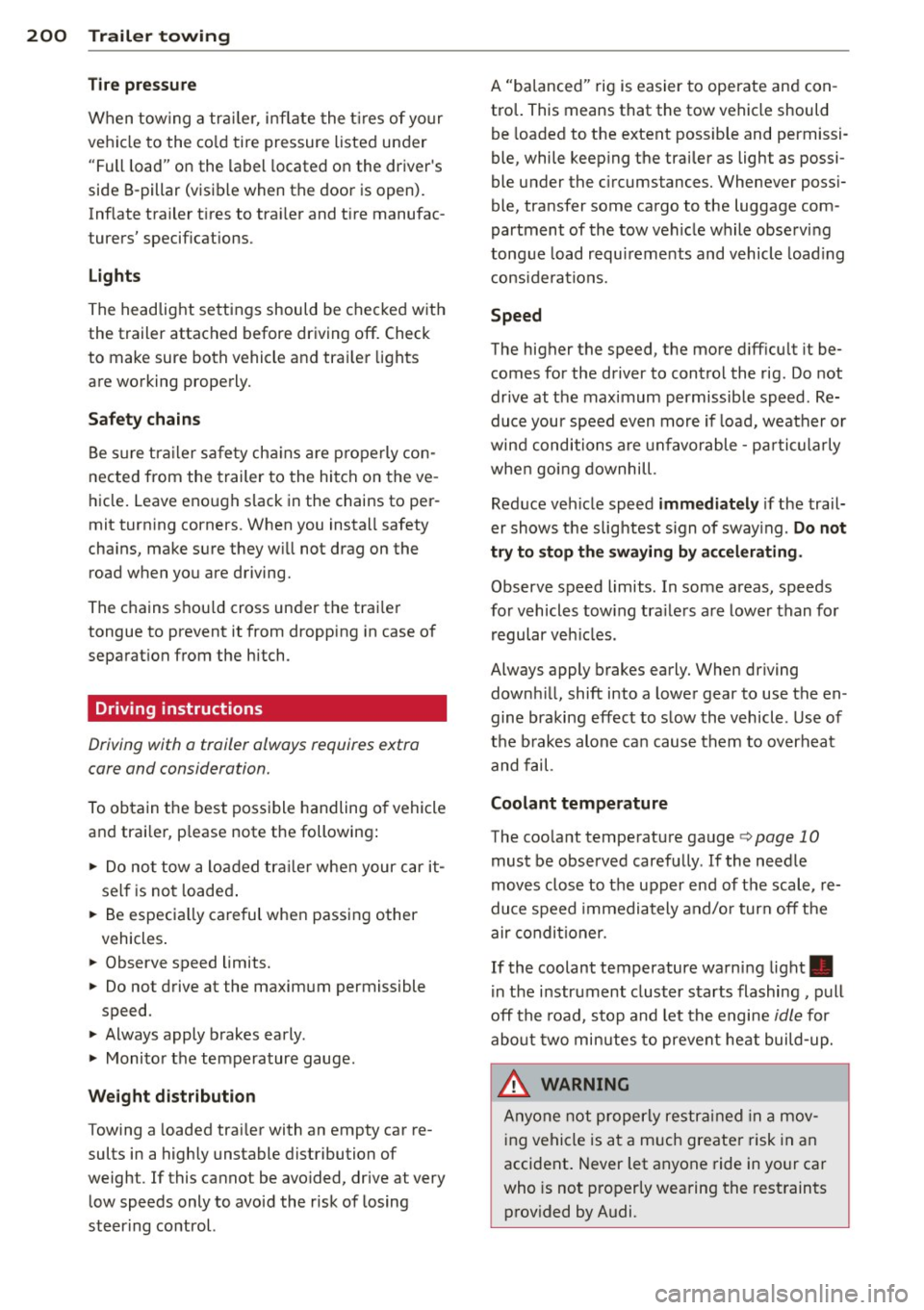
200 Trailer towing
Tire pressure
When towing a trai le r, inflate the tir es of your
vehicle to the cold tire pressure listed under
"Full load" on the label located on the driver 's
side B-pillar (visible when the door is open).
Inflate trailer tires to trailer and tire manufac
turers' specifications.
Lights
The headlight settings should be checked with
the trailer attached before dr iving off. Check
to make sure both vehicle and tra iler lights
are working properly.
Safety chains
Be sure trailer safe ty cha ins are properly con
nected from the trailer to the hitch on the ve
hicle. Leave eno ugh slack in the chains to per
mit turning corners. When you install safety
cha ins, make sure they w ill not drag on the
road when you are driving.
The chains shou ld cross under the trai ler
tongue to prevent it from dropping in case of
separation from the hitch.
Driving instructions
Driving with a trailer always requires extra
care and consideration.
To obtain the best possible handling of vehicle
and trai ler, p lease note the following:
.,. Do not tow a loaded trailer when your car it
self is not loaded .
.,. Be especia lly careful when passing other
vehicles .
.,. Observe speed limits .
.,. Do not drive at the maximum permissible
speed.
.,. Always apply brakes early.
.,. Monitor the temperature gauge.
Weight distribution
Towing a loaded trai ler with an empty car re
sults in a highly unstable distribution of
weight . If this cannot be avo ided, drive at very
low speeds only to avoid the risk of losing
steering control. A "ba
lanced'' rig is easier to operate and con
trol. This means that the tow vehicle should be loaded to the extent possible and permissi
ble, while keep ing the trailer as light as possi
ble under the c ircumstances. Whenever poss i
ble, transfer some cargo to the luggage com
partment of the tow veh icle while obse rving
tongue load requ irements and vehicle load ing
considerations.
Speed
The higher the speed, the more d iff icu lt it be
comes for the driver to control the rig. Do not
drive at the maximum permissible speed. Re
duce your speed even more if load, weather or
wind conditions are unfavorable -pa rticularly
whe n going downhill.
Reduce veh icle speed
immediately if the trail
er shows the slightest s ign of sway ing.
Do not
try to stop the swaying by accelerating.
Observe speed limits. In some areas, speeds
for vehicles tow ing trailers are lower than for
regular vehicles .
Always apply brakes early. When driving
downh ill, shift into a lower gear to use the en
gine braking effect to slow the vehicle . Use of
the brakes alone can cause them to overheat
and fail.
Coolant temperature
The coolant temperature gauge c> page 10
must be observed carefully . If the needle
moves close to the upper end of the scale, re
duce speed immediately and/or turn off the
air conditioner.
If the coolant temperature warning light •
in the in strument cluster starts flashing, pull
off the road, stop and let the engine
idle for
abo ut two minutes to prevent heat build-up .
_& WARNING
Anyone not properly restrained in a mov
in g vehicle is at a much greater risk in an
accident. Never let anyone ride in your car
who is not p roperly wea ring the restraints
provided by Audi.
-
Page 203 of 302
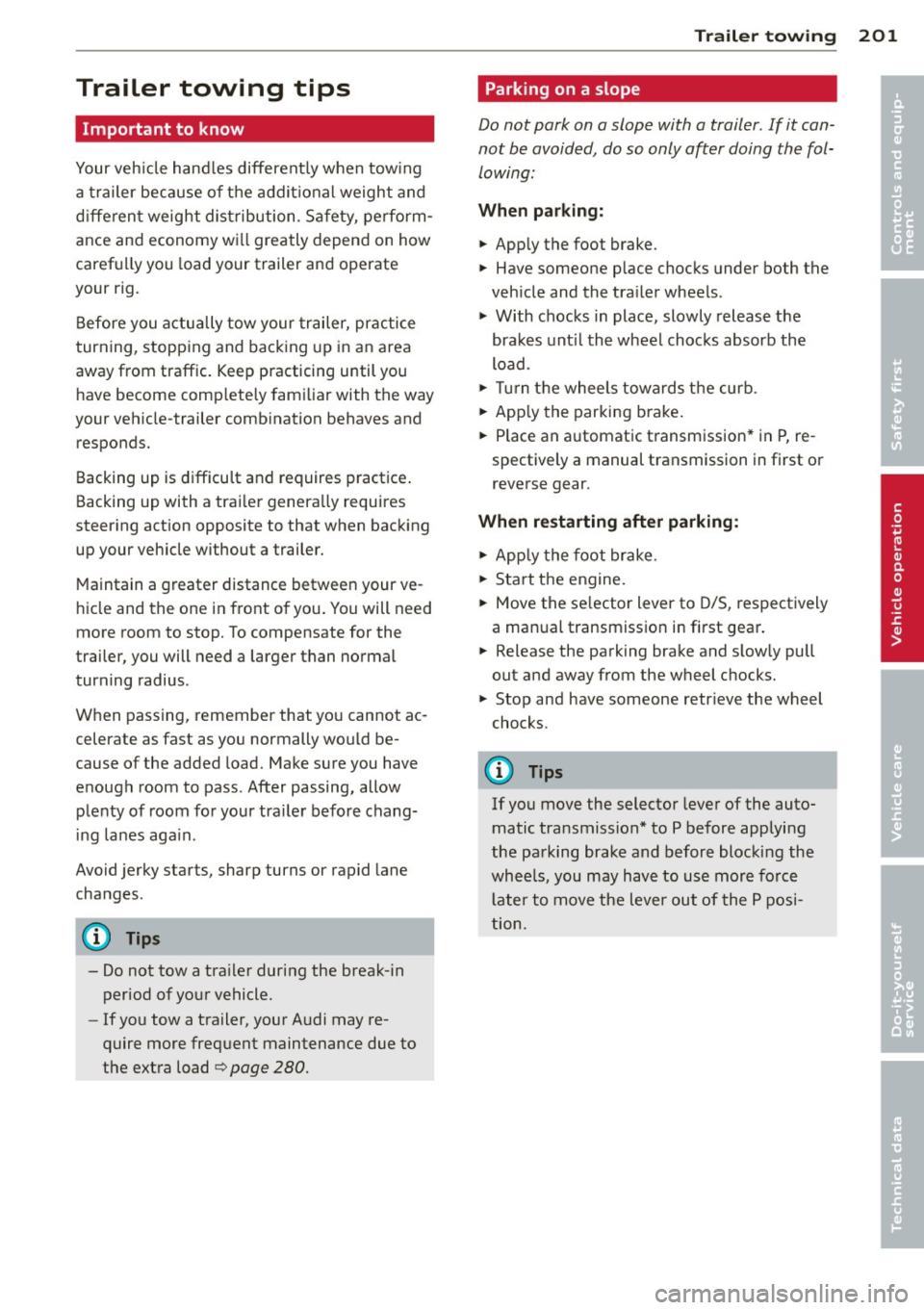
Trailer towing tips
Important to know
Your vehicle hand les different ly when tow ing
a trailer because o f the addit ional weight and
d iffe ren t weight distribution . Safety, pe rform
ance and economy w ill greatly depend on how
caref ully you load your trailer and operate
your rig.
B efore you actua lly tow your trailer, pr actice
turning, stopp ing and bac king up in an area
away from traffic. Keep practicing until you have become comp lete ly fam iliar with the way
your veh icle-trailer comb ination behaves and
responds.
Backing up is d ifficu lt a nd requires practice .
Backing up with a tra iler genera lly requires
steer ing action opposite to that when backing
up your vehicle without a trailer.
M aintain a g reater distance betwee n your ve
h icle and the one in front o f you . You will need
mo re room to stop. To compensate for the
trailer, you will need a larger than normal
turning radius .
W hen pass ing, remember that yo u cannot ac
celerate as fast as yo u normally wo uld be
cause of the added load. Ma ke s ure you have
e nough room to pass . After passing , allow
p lenty o f room fo r your tra iler before chang
in g la nes aga in .
Avoid jerky starts, sharp turns or rap id lane
changes.
(D Tips
- Do not tow a tra iler during the break-in
period of you r vehicle.
- If you tow a trailer, your A udi may re
quire more frequent maintenance due to
the extra load
o page 280.
Trailer towin g 201
Parking on a slope
Do not park on a slope with a trailer . If it can
not be avoided, do so only after doing the fol lowing:
When parking:
.. App ly the foot brake.
.. Have someone p lace chocks under both the
veh icle and the tra iler wheels .
.,. With chocks in place, slowly release t he
bra kes unt il t he whee l choc ks absorb the
load .
.. Tur n the whee ls towa rds t he curb .
.,. App ly the parking brake.
.. Place an a utomat ic t ransm ission* in P, re
spectively a manual transmission in first or
reverse gear.
When restarting after parking:
.. App ly the foot br ake .
.. Sta rt t he engine.
.. Move the se lector lever to D/S, respectively
a man ual transmiss ion in first gear .
.. Release the parking brake and s low ly pull
out and away from the wheel chocks .
.. Stop and have someone retr ieve the wheel
chocks.
@ Tips
If you move the selector leve r of the auto
matic transmissio n* to P before applying
the pa rking brake and befor e bloc king the
whee ls, you may hav e to use mor e forc e
la ter to m ove the lever out of the P p osi
tion.
•
•
Page 204 of 302
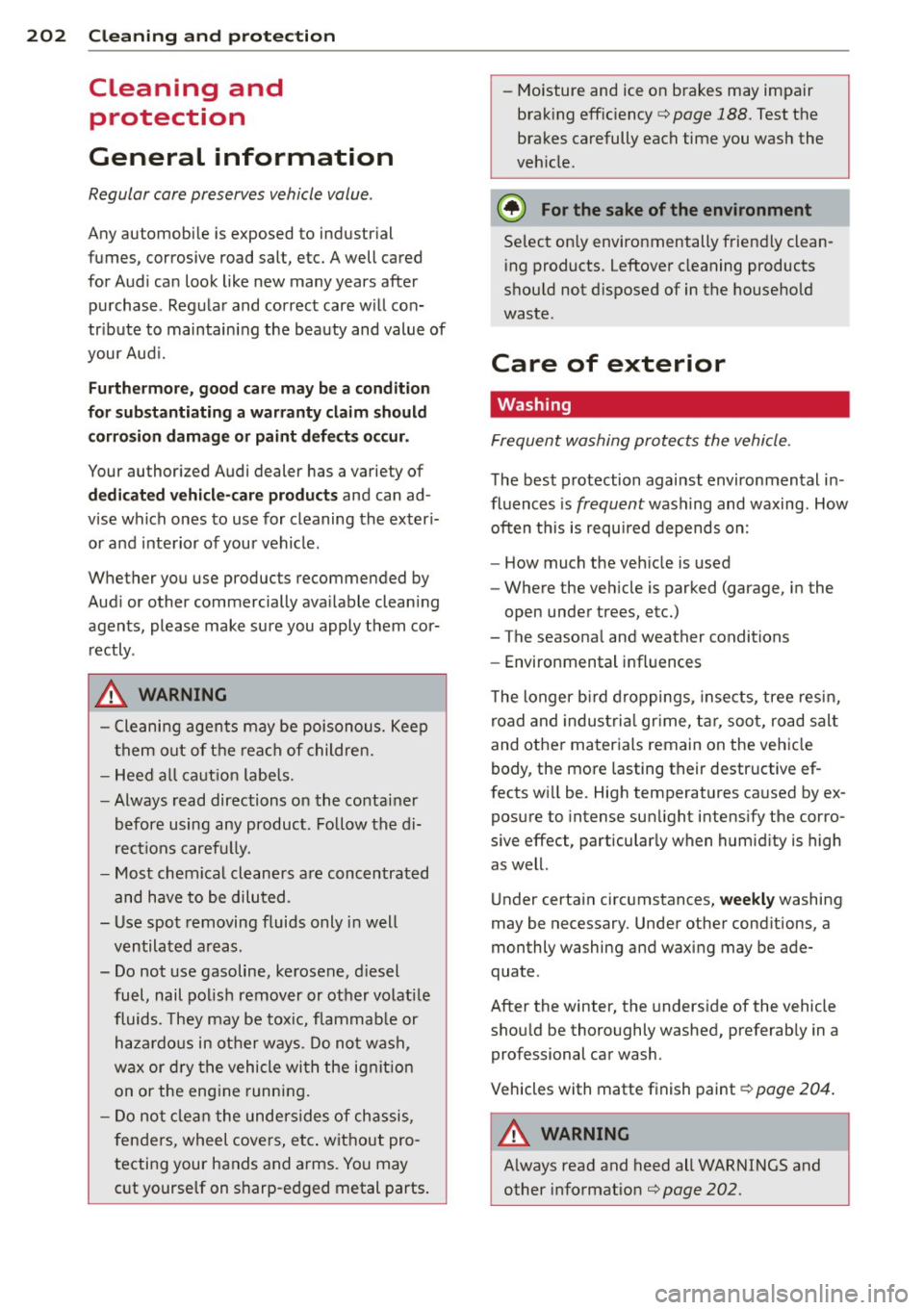
202 Cleaning and protection
Cleaning and protect ion
General information
Regular core preserves vehicle value .
Any automobile is exposed to industrial
fumes, corrosive road salt, etc. A well cared
for Audi can look like new many years after
purchase . Regular and correct care w ill con
tr ibute to maintaining the beauty and value of
your Aud i.
Furthermore, good care may be a condition
for substantiating a warranty claim should
corrosion damage or paint defects occur.
Your author ized Audi dealer has a variety of
dedicated vehicle-care products and can ad
vise which ones to use for cleaning the exter i
or and interior of your vehicle .
Whether you use products recommended by
Audi or other commercially available clean ing
agents, please make sure you apply them cor
rectly .
A WARNING
-Cleaning agents may be poisonous. Keep
them out of the reach of children.
- Heed all caut ion labels.
- Always read directions on the container
before using any product . Follow the di
rect ions carefu lly.
- Most chemical cleaners are concentrated
and have to be diluted.
- Use spot removing fluids only in well
ventilated areas.
- Do not use gasoline, kerosene, d iesel
fuel, nail pol ish remover or other volatile
fluids. They may be toxic, flammable or
hazardous in other ways. Do not wash,
wax or dry the vehicle with the ignit ion
on or the engine running.
- Do not clean the undersides of chassis,
fenders, wheel covers, etc. without pro
tecting your hands and arms. You may cut yourself on sharp-edged metal parts. -
Moisture and ice on brakes may impair
brak ing eff ic iency
c::> page 188. Test the
brakes carefully each time you wash the
veh icle.
@ For the sake of the environment
Select on ly environ mentally friendly clean
ing products. Leftover cleaning products
should not disposed of in the household
waste .
Care of exterior
Washing
Frequent washing protects the vehicle .
The best p rotection against environmental in
fluences is
frequent washing and waxing . How
often this is required depends on:
- How much the veh icle is used
- Where the vehicle is parked (garage, in the
open under trees, etc.)
- The seasona l and weather conditions
- Environmental influences
T he longer b ird droppings, insects, tree resin,
road and industria l gr ime, tar, soot, road salt
and other materials remain on the vehicle body, the more lasting their destructive ef
fects will be . High temperatures caused by ex
posure to intense sunlight intensify the corro
sive effect, particularly when humidity is high as well.
Under certain circumstances,
weekly washing
may be necessary. Under other conditions, a
monthly washing and waxing may be ade
quate .
After the winter, the underside of the vehicle
should be thoroughly washed, preferably in a
professional car wash.
Vehicles with matte finish paint
c::> page 204.
A WARNING
-A lways read and heed all WARNINGS and
other information
c::> page 202.
Page 205 of 302
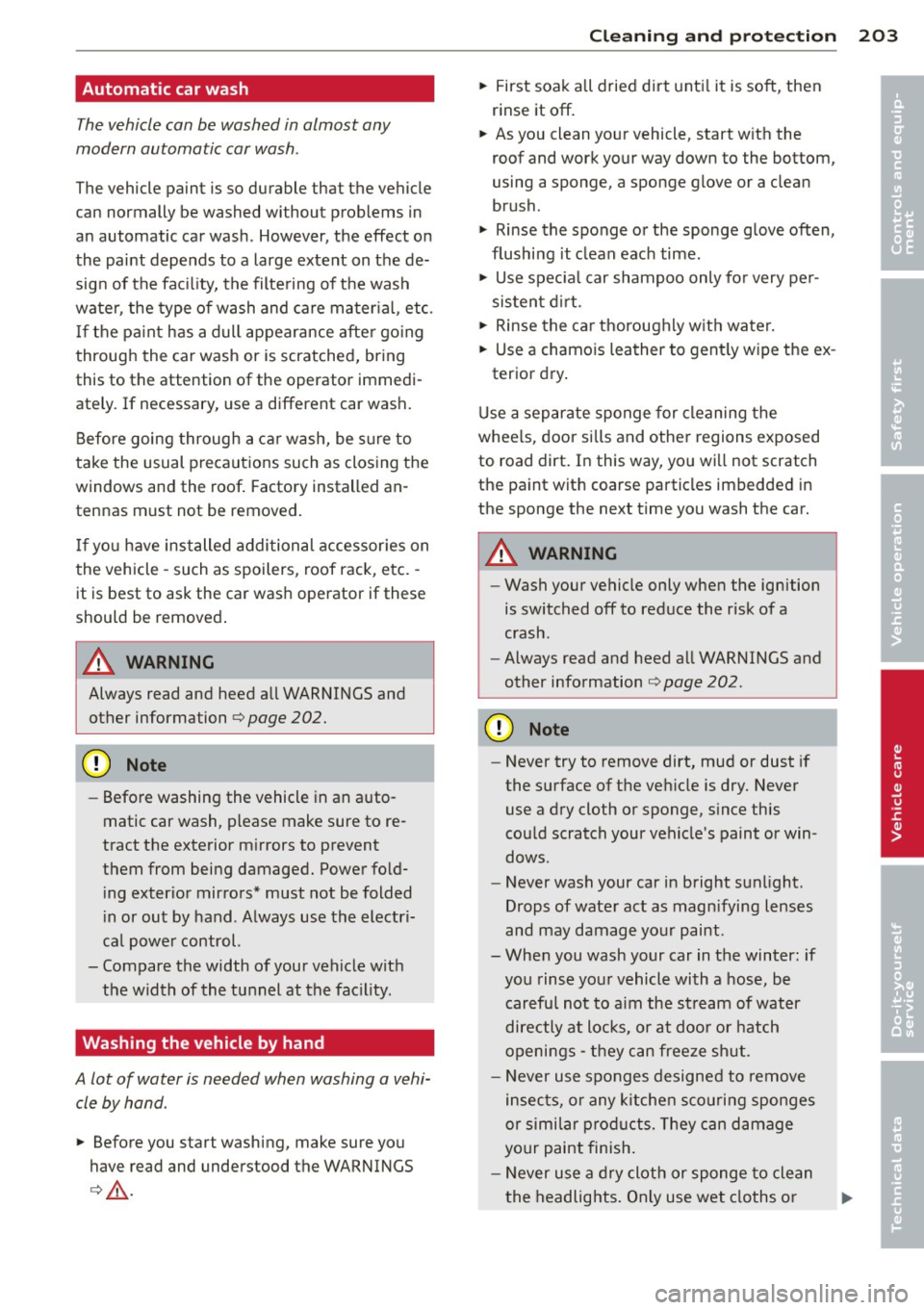
Automatic car wash
The vehicle can be washed in almost any
modern automatic car wash .
The vehicle paint is so durable that the vehicle
can normally be washed without problems in
an automatic car wash. However, the effect on
the paint depends to a large extent on the de
sig n of the fac ility, the filte ring of the wash
water, the type of wash and care mater ial , etc.
If the paint has a dull appearance afte r go ing
through the car wash or is scratched, bring
this to the attention of the operator immedi
ately. If necessary, use a different car wash.
Before going through a ca r wash, be s ure to
take the usual precautions such as closing the
windows and the roof . Factory installed an
tennas must not be removed.
If you have installed additional accessories on
the vehicle -such as spoilers, roof rack, etc. -
it is best to ask the car was h operator if these
should be removed .
A WARNING
Always read and heed a ll WARNINGS and
other information
r:=> page 202.
CD Note
-Before washing the vehicle in an auto
matic car wash, please make sure to re
tract the exterior m irrors to prevent
them from being damaged. Power fo ld
i ng exter ior mirrors* must not be folded
i n or out by hand . Always use the electri
ca l power control.
- Compare the width of your vehicle with the width of the tunnel at the fac ility.
Washing the vehicle by hand
A lot of water is needed when washing a vehi
cle by hand.
.,. Before you start washing, make sure you
have read and understood the WARNINGS
Q fr. .
Cleaning and protec tion 203
.,. First soak all dried dirt unti l it is soft, then
rinse it off.
.,. As you clean your vehicle, start w ith the
roof and work your way down to the bottom,
using a sponge, a sponge glove or a clean
brush .
.,. Rinse the sponge or the sponge glove often,
flushing it clean each time.
.,. Use spec ial car shampoo only fo r
very per
sistent d irt.
.,. Rinse the car thoroughly w ith water.
.,. Use a chamois leather to gent ly wipe the ex -
terior dry .
Use a separate sponge for cleaning the
whee ls, door s ills and other regions exposed
to road dirt. In this way, you wi ll not scratch
the paint with coarse particles imbedded in
the sponge the next time you wash the car.
A WARNING
- Wash your vehicle only when the ignition
is switched off to reduce the risk of a
crash .
- Always read and heed all WARNINGS and
other information
r=> page 202 .
CD Note
-Never try to remove dirt, mud or dust if
the surface of the veh icle is dry. Never
use a dry cloth or sponge, s ince this
could scratch your vehicle's paint or win
dows .
- Never wash your car in bright sunlight.
Drops of wate r act as magn ifying lenses
and may damage yo ur paint .
- When you wash your car in the winter: if you rinse your vehicle with a hose, be careful not to aim the stream of water
directly at locks, or at door or hatch
openings - they can freeze shut.
- Never use sponges designed to remove
insects, or any k itchen scouring sponges
or similar p rod ucts. They can damage
your paint finish .
- Never use a dry cloth or sponge to clean
the headlights . Only use wet cloths o r •
•
Page 206 of 302

204 Cleaning and protec tio n
sponges to prevent scratches. It is best
to use soapy water .
- You should remove debris (such as in
sects) from the headlight lenses on a
regular basis, for example when refuel
ing your vehicle. Never use a dry cloth or
sponge to clean the head lights. Only use
we t cloths or sponges to prevent
scratches . It is best to use soapy water .
@) For the sake of the environment
Only wash the vehicle in facilit ies specially
designed for that purpose. Th is w ill reduce
the risk of d irty water contaminated w ith
oil from entering the sewer system . In
some areas, wash ing vehicles outs ide of
these facilities is prohib ited.
Washing your vehicle with a power
washer
Cleaning the exterior of your car with a high
pressure power washer is safe as long as you
observe a f ew simple rules.
• Before using the power w asher , make sure
yo u have read and understood the WARN
INGS
q A in General information on
page 202.
• Always fo llow the operating instructions for
the power washer.
• Make sure that the jet o n the spray hose
produces a "fan shaped spray" .
• Do
not hold the spray nozzle too close to
soft materia ls .
Keep a d is tance from soft materials such as
rubber hoses o r insulat ing mater ial as we ll as
sensors and camera lenses .
When cleaning t he vehicle wit h a power wash
er
always fo llow the operating instructions .
This applies particularly to the operating pres
sure and the spraying distance . Do not po int
the spray direc tly at the sea ls around the s ide
windows, aro und t he doors, on the re ar lid or
on the sunroof* . Likew ise, do not point it di
rectly at tires, r ubber hoses, ins ulation mate
rial or sensors
q page 205. Hold the spray nozzle at least 1.3 ft (0.4 m) away from the
vehicl e.
Do no t use a high-pressu re power was her to
remove snow and ice .
Do not use a jet which sprays water in a d irect
st ream o r one that has a rotating je t.
Water temperature should not exceed 140 °F
(60 °() .
A WARNING ,..__
Neve r wash t ires with a jet that sprays wa
ter in a direct stream . Thi s could cause in
v is ible d amage to the t ires and weaken
them, even if the spray is from a relative ly
l ong distance and for a short time . Dam
aged and wea kened tires can fail a nd cause
accidents and personal in jury.
(D Note
To avoid damaging yo ur vehicle, a lw ays
make sure tha t the re is sufficien t distance
betwee n the spray head and soft materia ls
lik e rubbe r hoses, plast ic parts and sound
deaden ing mater ia ls as well as sensors
and camera lenses. Never a im the spray
head at the same point fo r a long time.
This also app lies to cleaning headlights
and paint ed bumpers . Remembe r: t he
closer the no zzle is to the surfa ce of the
m at erial , the gre ater t he s tress on the ma
terial.
Caring for vehicles with matte finish
paint
Applies to vehicles: wit h matte finish paint
Vehicles with matt e finish paint require spe
cial care due to the characteristics of the
paint.
Washing by hand
T o avoid damaging the pain t when was hing,
fi rst remove dust and la rge particles from
yo ur vehicle . Insects, grease spots and finger
prints are best removed with a
special cleaner
for matte finish pa int .
1111>
Page 207 of 302

Apply the product using a microfiber cloth . To
avoid damaging the paint surface, do not use
too much pressure .
Rinse the vehicle tho roughly with water . Clean
the vehicle starting at the top and working to
ward the bottom using a
neutra l sh ampoo
and a soft mi crofiber cloth . Stop frequently to
rinse the cloth thorough ly.
Clean the wheels and sill panels last. Use a
clean
s pon ge on these areas .
R inse the vehicle tho roughly aga in and let i t
a ir dry. If there are any wa ter spots, they can
be removed using a
le ather cloth.
Clea n again with the sp ecial cl eaner for matt e
finish paint
i f ne cessary.
Removing stubborn dirt
B ird dropping s or tree sap a re best removed
with plenty of water and a m icrofiber cloth .
You shou ld r inse off
gasoline residue immedi
ately with plenty o f water.
A WARNING
- Wash your veh icle only when the ignition
is switched off to reduce the risk of a
c rash .
- Always read and heed all WARNINGS and
other information ¢
page 202.
0 Note
-Do not treat vehicle parts painted w ith
matte f inish paint usi ng polish ing mate
r ials or hard wax . These products could
cause damage to the appearance or sur
face that cannot be repaired.
- Never use p rotective wax. It can destroy
the matte fin ish effect .
- Do not p lace any st ickers or magne tic
s igns on vehicle parts painted with
matte finish paint. The pa int co uld be
damaged when the stickers or magnets
are removed.
- To prevent pa int damage, do not wash
the veh icle in direct sun ligh t.
Cleaning and protec tion 205
- To prevent damage to the pa int sur face,
do not use insect remova l sponges ,
rough kitchen sponges or sim ila r items .
- Yo u should remove deb ris (such as in
sects) from the headlight lenses on a
regu lar bas is, for example when refuel
ing your vehicle . Only clean the head
lights using a wet cloth or sponge, never
a dry one. Cleaning with soapy water is
recommended.
(D Tips
For more information on special cleaning
products designed for matte finish paint,
see your Aud i deale r.
, Sensors and camera lenses
- Remove snow with a hand brus h and remove
ice with a de- ic ing sp ray that does not con
t ain so lvents.
- Clean the senso rs (adaptive cruise co ntrol*,
pa rking system*) w ith a cleaning so lution
tha t does not contain so lvents and a soft
cloth .
(D Note
-If you wash your vehicle with a pressure
washer,
- make sure there is enough distance to
sensors i n the rear bumper.
- do not clean the camera lenses and the
area around them with the pressure
washer.
- Never use warm or hot water to remove
snow or ice from the camera lens. This
cou ld cause the lens to crack .
- Never clean the camera lens with abra
sive products .
Waxing and Polishing
Waxing
A good wax coating protects the vehicle paint
to a large extent against the environmental
factors listed under~
page 202, Washing and
even against s light scratches.
ii,.
•
•
Page 208 of 302
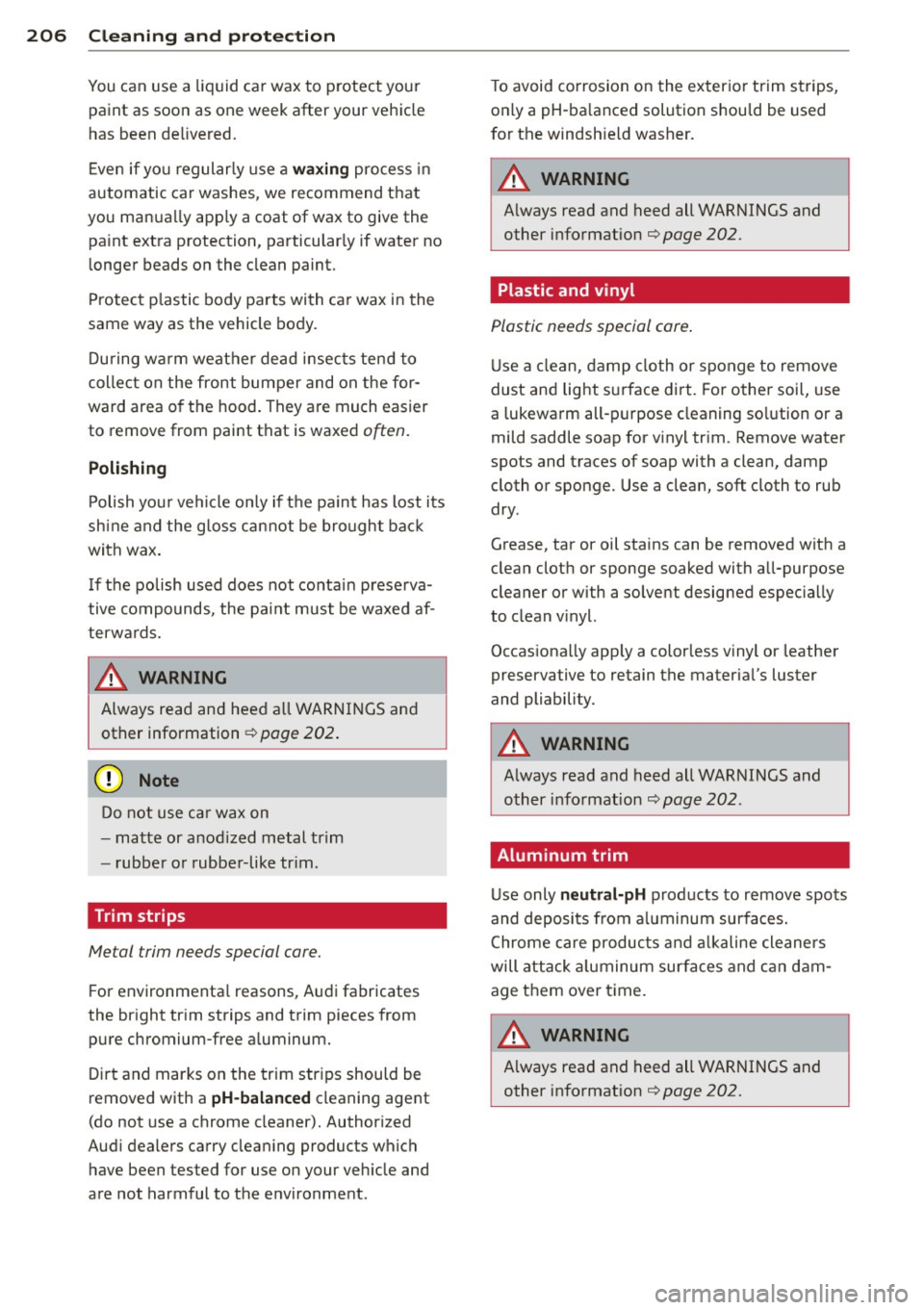
206 Cleaning and protection
You can use a liquid car wax to protect your
paint as soon as one week after your vehicle
has been de livered.
Even if you regularly use a
waxing process in
automatic car washes, we recommend that
you manua lly app ly a coat of wax to give the
pa int extra protection, particular ly if water no
longer beads on the clean paint.
Protect plastic body parts with car wax in the
same way as the vehicle body.
During warm weather dead insects tend to
collect on the front bumper and on the for
ward area of the hood. They are much easier
to remove from paint that is waxed
often.
Polishing
Polish your vehicle only if the paint has lost its
shine and the gloss cannot be brought back
with wax.
If the polish used does not contain preserva
tive compounds, the paint must be waxed af
terwards.
A WARNING
Always read and heed all WARNINGS and
other information
¢page 202.
(D Note
Do not use car wax on
- matte or anod ized metal trim
- rubber or rubber-like trim .
Trim strips
Metal trim needs special care.
For environmenta l reasons, Audi fabricates
the bright trim strips and trim pieces from pure chromium-free aluminum.
Dirt and marks on the trim strips should be
removed with a
pH-balanced cleaning agent
(do not use a chrome cleaner). Authorized
Aud i dealers carry cleaning products which
have been tested for use on your vehicle and
are not harmful to the environment . T
o avoid corrosion on the exterior trim strips,
only a pH-ba lanced solution should be used
for the windsh ield washer.
A WARNING "--
Always read and heed all WARNINGS and
other information
¢ page 202.
Plastic and vinyl
Plastic needs special care .
Use a clean, damp cloth or sponge to remove
dust and light surface dirt. For other soil, use
a lukewarm all-purpose cleaning solution or a
mild saddle soap for vinyl trim. Remove water
spots and traces of soap with a clean, damp
cloth or sponge. Use a clean, soft cloth to rub
dry .
Grease, tar or oil stains can be removed with a
clean cloth or sponge soaked with all-purpose
cleaner or with a solvent designed espec ially
to clean v inyl.
Occasiona lly app ly a colorless vinyl or leather
preservative to retain the material's luster
and pliability .
A WARNING
Always read and heed all WARNINGS and
other information
¢ page 202.
Aluminum trim
Use only neutral-pH products to remove spots
and deposits from aluminum surfaces.
Chrome care products and alkaline cleaners
will attack aluminum surfaces and can dam
age them over time.
A WARNING
A lways read and heed all WARNINGS and
other information
¢ page 202.
Page 209 of 302
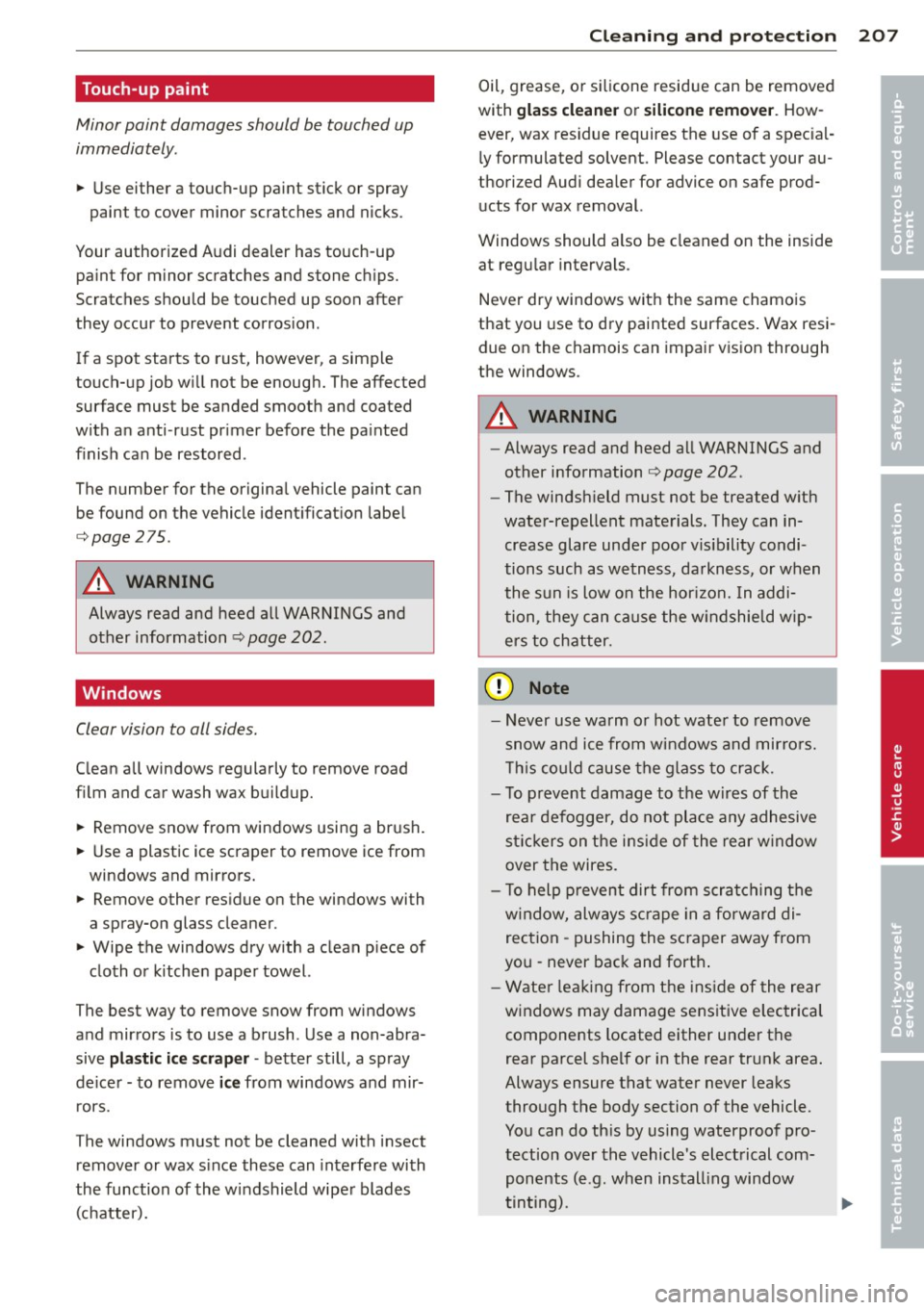
Touch-up paint
Minor paint damages should be touched up
immediately.
11-Use either a touch-up paint stick or spray
paint to cover minor scratches and nicks .
Your authorized Audi dealer has touch-up paint for minor scratches and stone chips.
Scratches should be touched up soon after
they occur to prevent corros ion.
If a spot starts to rust, however, a simple
touch-up job w ill not be enough. The affected
surface must be sanded smooth and coated
with an anti-rust pr imer before the pa inted
f inish can be restored.
The number for the original vehicle paint can be found on the vehicle ident ificat ion label
¢page 275.
A WARNING
Always read and heed a ll WARNINGS and
other information
¢ page 202.
Windows
Clear vision to all sides.
C lean a ll windows regularly to remove road
fi lm and car wash wax buildup.
11-Remove snow from windows using a br ush .
11-Use a plastic ice scraper to remove ice from
windows and mirrors.
11-Remove other res idue on the windows with
a spray-on glass cleaner.
11-Wipe the windows dry with a clean p iece of
cloth or kitchen paper towel.
The best way to remove snow from windows and mirrors is to use a brush. Use a non-abra
sive
p lastic ic e scraper -better still, a spray
de icer - to remove
ic e from windows and mir
r ors.
The windows must not be cleaned with insect remover or wax s ince these can interfere with
the function of the w indshield wiper blades
(chatter).
Cleaning and protec tion 207
Oil, grease, or si licone residue can be removed
with
gl ass clea ne r or s ilicon e remo ve r. How
ever, wax res idue requires the use of a spec ia l
l y formulated solvent. Please contact your au
thorized Audi dealer for advice on safe prod
ucts for wax removal.
Windows should also be cleaned on the inside
at regu lar intervals.
Never dry windows with the same chamois
that you use to dry painted surfaces . Wax resi
due on the chamois can impair v is ion through
the windows .
A WARNING
-Always read and heed all WARNINGS and
other information
c> page 202.
- The windsh ield must not be treated w ith
water-repellent materials. They can in crease glare under poor v is ibility condi
tions such as wetness, darkness, or when
the sun is low on the hor izon. In addi
tion, they can cause the w indshie ld w ip
ers to chatter.
0 Note
- Never use warm or hot wate r to remove
snow and ice from windows and mirro rs.
Th is could cause the glass to crack.
- To p revent damage to the w ires of the
rear defogger, do not place any adhesive
st ic kers on the ins ide of the rear w indow
over the wires.
- T o help p revent dirt from scratching the
w indow, always sc rape in a forward di
rection -pushing the sc raper away from
you - never back and forth .
- Wate r lea king from the ins ide of the rear
w indows may damage sensitive electrica l
components located either under the
rear parcel shelf or in the rear trunk area.
Always ensure that water never leaks through the body section of the vehicle.
You can do th is by using waterproof pro
tection over the vehicle's elect rical com
ponents (e .g. when instal ling window
tinting).
•
•
Page 210 of 302
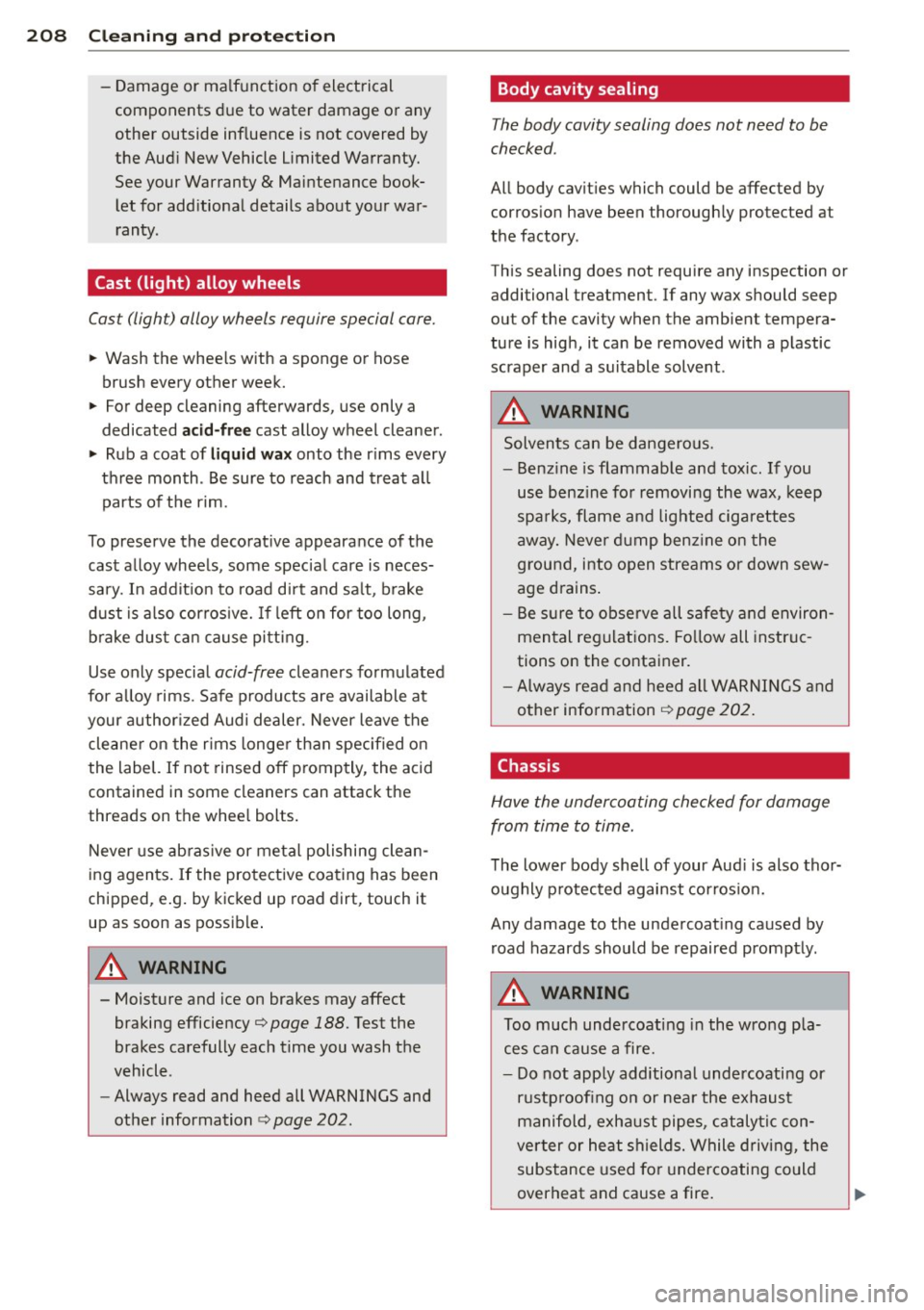
208 Clea ning and protec tio n
- Damage or ma lfunction of electrical
components due to water damage or any
other outside influence is not covered by
the Aud i New Vehicle Limited Warranty.
See your Warranty
& Maintenance book
l et for additional details about your war
ranty.
Cast (light) alloy wheels
Cast (light) alloy wheels require special care.
.. Wash the whee ls with a sponge or hose
brush every other week.
.. For deep cleaning afterwards, use only a
dedicated
aci d-fr ee cast alloy wheel cleaner.
.. Rub a coat of
liqui d wax onto the r ims every
three month . Be sure to reach and treat a ll
parts of the rim.
To preserve the decorat ive appearance of the
cast alloy wheels, some specia l care is neces
sary. In addit ion to road d irt and sa lt , brake
dust is a lso cor ros ive.
If l eft on for too long,
brake dus t can cause pitting.
Use only specia l
acid-free cleaners formulated
for a lloy rims. Safe p roducts are available at
your author ized Audi dealer. Never leave the
cleane r on the rims longer than specified on
the label. If not rinsed
off promptly, the acid
contained in some cleaners can attack the
threads on the whee l bolts.
Never use ab ras ive or metal polishing clean
ing agents. If the protective coating has been
chipped, e .g. by kicked up road dirt, touch it
up as soon as possible .
.&, WARNING
-Moisture and ice on brakes may affect
braking efficiency¢
page 188. Test the
brakes carefully each time you wash the
vehicle .
- Always read and heed all WARNINGS and
other information
¢ page 202.
Body cavity sealing
The body cavity sealing does not need to be
checked .
All body cav ities which could be affected by
corros ion have been thoroughly protected at
the factory .
This sealing does not require any inspection or additional treatment. If any wax should seep
out of the cavity when the ambient tempera
ture is high, it can be removed with a plastic scraper and a suitable solvent .
.&, WARNING '"-'--
Solvents can be dangerous .
- Benz ine is flammable and toxic. If you
use benz ine for removing the wax, keep
spa rks, flame and lighted cigarettes
away. Never dump benz ine on the
g round, into open streams or down sew
age drains .
- Be s ure to observe all safety and environ
mental regulations. Follow all instruc
tions on the container.
- Always read and heed all WARNINGS and
other information ¢
page 202.
Chassis
Have the undercoating checked for damage
from time to time.
The lower body shell of your Aud i is also thor
oughly p rotected against corros ion.
Any damage to the undercoat ing caused by
road hazards should be repaired promptly .
.&, WARNING
Too much undercoating in the wrong p la
ces can cause a fire.
- Do not app ly additional undercoating or
r u stp roofing on or nea r the exhaust
manifold, exhaust pipes, catalyti c con
ver ter or heat shields. While driving, the
substance used for undercoating could
overheat and cause a fire.